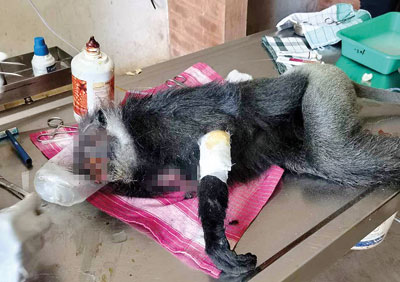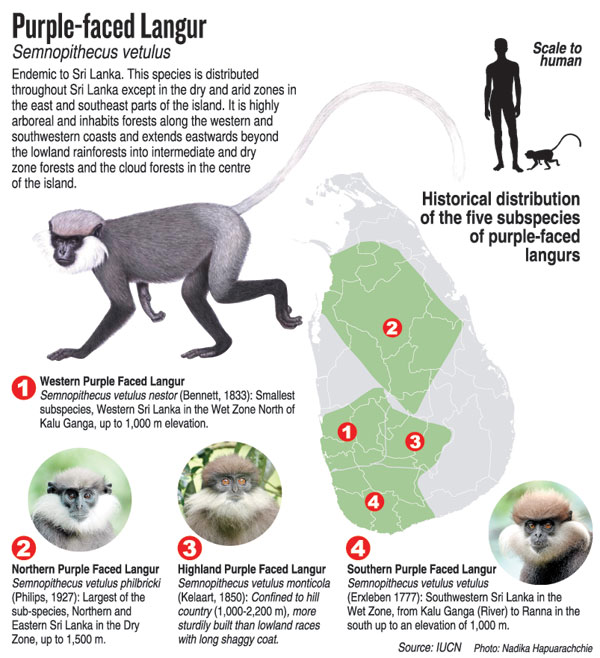News
Power lines and habitat destruction fatal for langurs
View(s):By Kasun Warakapitiya
The loss of canopy in home gardens and fragmentation of lush areas have driven purple-faced monkeys, or “Kalu Wandura”, to suffer death or injuries when they move using power lines.
A senior wildlife official explained that uninsulated Ceylon Electricity Board power lines had caused the deaths of many monkeys, and maimed others for life. 
Wildlife Department veterinary surgeon Dr. Suhada Jayawardana, who is in charge of the Western region and the Attidiya Rehabilitation Centre, said more than 300 critically endangered western purple-faced langur monkeys (Semnopithicus vetulus nestor) were injured every year. Among them, more than 100 were injured due to electrocution.
“Most electrocuted monkeys fall from electricity poles and suffer secondary injuries, get run over by vehicles, or get attacked by dogs. Many of them die. Very few recover. Some remain maimed for life and are unable to be released into the wild,” he said.
At present, 40 western purple-faced langur monkeys are being treated. Some are young animals, some are babies.
Leading primatologist and Primatological Society of Sri Lanka (PSSL) President Dr Jinie Dela explained that the purple-faced langur (Semnopithecus vetulus) is listed as ‘endangered’.
There are five sub-species of purple-faced langurs: Semnopithecus vetulus vetulus, Semnopithecus vetulus nestor, Semnopithecus vetulus monticola, Semnopithecus vetulus philbricki, and Semnopithecus vetulus harti.
The western subspecies, Semnopithecus vetulus nestor, found mainly in home gardens and rubber plantations in the western lowlands, is listed as ‘critically endangered’ by IUCN, she noted.
“I have been studying the nestor subspecies since 1985. Back then, when I started my studies, these langurs were plentiful. However, they were much more difficult to see in most places we visited during a 2007-2010 survey,” she said.
Dr Dela said the nestor subspecies lived mostly in spacious home gardens with large trees and rubber lands, mainly in the Western Province.
When people divide or sell their lands for housing projects, gardens are fragmented, and the new owners are unable to maintain large food trees (such as jak) which the monkeys need, she said.
They are, therefore, deprived of their habitats and pockets.
“Unlike the other sub-species of purple-faced langur, ‘nestor’ does not have sizeable forests or major protected areas to secure at least a few populations — despite the loss of home garden habitats,’’ she said.
“We have been working with the Forest Department at Waga since 2015 (disrupted somewhat by Covid-19 and fuel crisis) to see how small forest patches in the ‘nestor’ range can be enriched, linked, buffered, and secured as refuges for the langur in the future.’’ She said the PSSL, had prepared an umbrella policy document for the Wildlife Department to address the human-wildlife conflict. Workshops had been held by the National Man and the Biosphere Committee (MAB) and the National Science Foundation (NSF) to identify vital actions needed to address the human-monkey conflict.
She felt that implementing these plans would be a first step. If not, valuable effort, time, and funds would be wasted. Wildlife Department Director General Chandana Sooriyabandara said talks were planned with the CEB to ask them to use insulated wires at least in areas inhabited by monkeys.
He said the department could not incur extra costs.

The best way to say that you found the home of your dreams is by finding it on Hitad.lk. We have listings for apartments for sale or rent in Sri Lanka, no matter what locale you're looking for! Whether you live in Colombo, Galle, Kandy, Matara, Jaffna and more - we've got them all!

